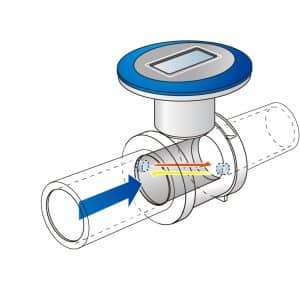An ultrasonic meter works by sending ultrasonic pulses between transducers through a fluid in a pipe. It measures the difference in transit times of these pulses downstream and upstream, which correlates to the fluid’s flow velocity, and consequently, the flow rate. This technology enables accurate fluid flow measurement.
The Role of Ultrasonic Pulses and Transit Time
The primary components of an ultrasonic flow meter are two transducers. These act as both ultrasonic signal generators and receivers in the same sensor body. They emit ultrasonic pulses, which are essentially sound waves at a high frequency above the range of human hearing.
One sensor or transducer sends an ultrasonic pulse downstream into the flow of the fluid, while the other second transducer sends a pulse upstream. The transit time downstream is less than the transit time upstream due to the velocity of the fluid flow. By calculating the difference between these two transducers’ transit times, the meter can accurately determine the flow velocity.
Doppler Ultrasonic Flow Meters Vs. Transit Time Flow Meters
There are two main types of ultrasonic flow meters: Doppler flow meters and transit time flow meters. While both use sound waves to measure flow velocity, they differ in the way they interpret the return signal.
A Doppler ultrasonic flow meter works by reflecting an ultrasonic beam off suspended particles or gas bubbles into a stream of flowing liquid. The frequency shift of the return ultrasound signal, known as the Doppler shift, is directly proportional to the velocity of the fluid.
On the other hand, transit time ultrasonic flow meters measure the flow by using pairs of transducers in a configuration where the ultrasonic sensor signal crosses the flow path twice in opposite direction through the pipe wall and into the flow. The time difference between the signals referred to as transit time, is used to calculate the flow velocity.
One crucial aspect of understanding how an ultrasonic meter works is recognizing the influence of the fluid’s characteristics and the flow path. The ultrasonic signal’s successful transit across the fluid relies on the medium being free of obstructions that could scatter or absorb the sound waves.
The Importance of Fluid Characteristics and Flow Path
The fluid should not contain a high concentration of solid particles or gas bubbles as they can disrupt the ultrasonic waves. For instance, a Doppler flow meter relies on the fluid having enough bubbles or particles to reflect the signal, but too many can hinder the signal entirely.
The flow path, or the route the ultrasonic signal takes through the fluid, also impacts the measurement accuracy. If the flow is turbulent, the signal may be diffused, leading to inaccurate readings. Thus, meters often include a straight line or lengths of pipe on either side of the sensor body to ensure a smooth, regular flow path.




























































